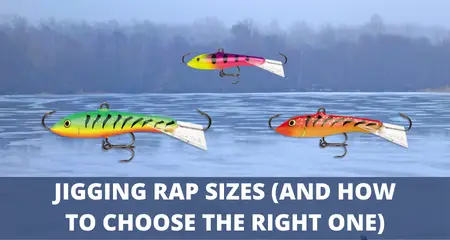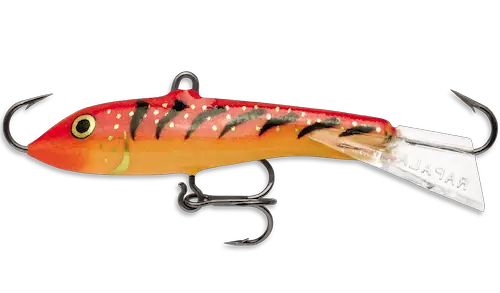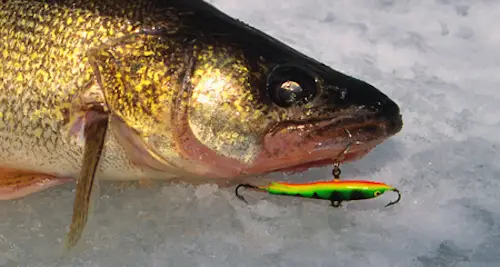Jigging Rap Size Chart (And How To Choose The Right One)
UPDATED 18 MAY 2023
by Robert Ceran
Are you wondering what size jigging rap to use?
While Rapala’s jigging rap is one of the most popular ice fishing lures on the market, many anglers still don’t know how to use it effectively.
If you want to get the best results with your jigging rap, you need to start by choosing the right size for your specific application.

In this article we’ll walk you through the different jigging rap sizes, and how to choose the ideal size for your purposes.
Read on below to find out how to put more fish on ice with this legendary ice fishing lure!
Jigging rap size chart
| Jigging rap size | Weight | Body length | Hook size | Recommended fish species |
|---|---|---|---|---|
| 02 | 1/8 oz | 1.25 inches | #14 | Bluegill, Yellow Perch |
| 03 | 3/16 oz | 1.5 inches | #12 | Crappie, Bluegill, Yellow Perch |
| 05 | 5/16 oz | 2 inches | #10 | Crappie, Lake Trout |
| 07 | 5/8 oz | 2.75 inches | #7 | Walleye, Bass, Lake Trout |
| 09 | 7/8 oz | 3.5 inches | #6 | Northern Pike, Walleye, Bass, Lake Trout |
The table above shows all sizes of jigging raps made by Rapala, as well as their weight, length, and hook size.
In addition, the last column gives our recommendation for what fish species to target with each size jigging rap.
While the Rapala jigging rap series is most commonly used for panfish and walleye ice fishing, it can catch a wide range of other fish, and is also surprisingly effective for open water fishing.
How to choose the right size jigging rap
The most important consideration when choosing the right size jigging rap is the fish species that you want to target.
While the smallest sizes (2 and 3) are best suited for bluegill, yellow perch, and other small panfish, size 5 is a good choice for crappie.
Size 7 is most often used for walleye, but also works well for bass and lake trout.
Finally, size 9 is best suited for northern pikes, but can also work well for walleye, bass, and lake trout (especially when targeting these species in deep water).
Water depth
As a rule of thumb, you can use smaller jigging raps when fishing in shallow water, while you need to use larger ones when fishing in deep water.

This is because small jigging raps sink more slowly than big ones, and thus take a long time to sink down in the water column if you’re fishing deep.
However, you’ll have to balance this with other factors, such as size of the fish you’re targeting, as well as trying to match the hatch (i.e. the size of the baitfish that your target fish are keyed in on) at any given time.
Water temperature
Since fish feed more actively in warm water, you can catch them with larger lure profiles in summer and fall, while they respond better to smaller lure profiles in winter and spring.
This is especially true when trying to catch fish that are finicky, when it’s often best to downsize to smaller jigging raps.
Because of these considerations, I like to use an ice fishing fish finder or flasher to keep a close eye on how the fish are reacting to my lure.
If I notice that they’re interested and coming up to mark my rap as I snap it up and let it sink down, but not actually eating it, I’ll often downsize to a smaller one to see if that works better.
What size jigging rap should you use for walleye?
The best all-around size jigging rap for walleye is 07, which works well for both ice fishing and open water fishing.

However, other sizes can be more effective, depending on season, depth, water temperature, and what the walleye are feeding on.
Size 05 is often better early in the season, when the walleye are still sluggish, since this size has a slower fall, and can be worked more slowly for slow-moving walleyes.
In contrast, size 09 becomes more effective in summer, when walleye are found in deeper water.
This is because a heavier jigging rap allows you to reach deep water faster, and since walleye are more active in warm water, they also respond better to larger lure profiles.
Related: How to jig for walleye ice fishing
When to use a jigging rap
Jigging raps were originally developed for ice fishing, which makes perfect sense if you look at their flattened tail region.
This gives them an erratic sideways swimming motion when you pull them up and down in the water column, resembling a wounded baitfish trying to get away from a predator.
And while they were originally developed for vertical fishing through the ice (and are often described as the “deadliest ice fishing lure ever made” by ice anglers), they can also work extremely well during summer.
As a rule of thumb, jigging raps work best when you can position yourself on top of a school of fish, and fish them vertically.
The beauty of this fishing lure type is that you can easily adjust the depth at which you fish it, which is perfect for targeting suspended fish (though you’ll need to use a sonar to find the right depth).
Finally, you can also cast and retrieve a jigging rap, or even slow troll it with an electric trolling motor.
However, be aware that it’s best to do this in open water, since a jigging rap gets easily hung up on tree trunks, rocks, or other cover when pulled horizontally through the water column.
Should you tip your jigging rap with bait?
Most ice anglers like to tip their ice fishing jigs with bait, such as a perch eye, shiner, or wax worms.
The scent and texture of the bait can help to entice fish that are drawn in by the movement of the lure to go ahead and eat it.
And while this can work well with jigs, it’s not recommended to do this with Rapala jigging raps.
This is because they have a very characteristic action in the water column, which is generated by their flat tail region, and which works extremely well for triggering strikes from hungry fish.
If you add natural bait to one of the hooks of your lure, this will impair its swimming action in the water, which defeats the purpose of using a jigging rap in the first place.
